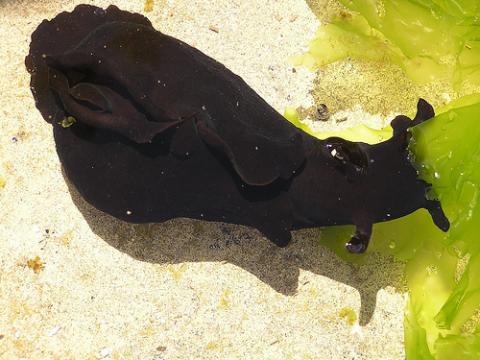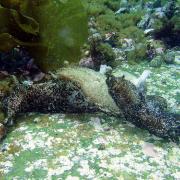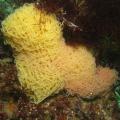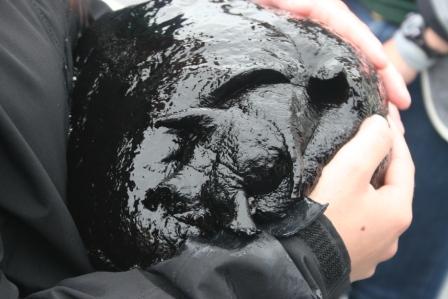
Come down to the Bait House Aquarium soon to see our special, once a year guests!
Every year, between March and the end of June, we find these odd but very interesting molluscs showing up on the rocky shores all around Wellington. Sea Hares (or Sea Bunny) are closely related to nudibranchs (cousins of marine snails but without shells). They're called Sea Hares because they have chemical receptors on their heads that look like rabbit ears and they crawl around eating seaweeds, especially sea lettuce. 
Along with the chemical receptors on their head, Sea Hares have two tentacles on either side of the mouth that detect chemicals in the water and which they use to find food. Their eyes are simple and are only able to detect light from dark. Sea Hares don't have a brain, but rather groups of nerve cells called ganglia.
Most species have a thin, internal shell, protecting the gill and heart. The mantle cavity is covered by large flaps called parapodia that are used in some species to "swim" through the water. These flaps look like "ruffles" on the backs of sea hares.
Like land and sea snails, Sea Hares have one foot that they crawl around on. To eat seaweeds, they use jaws and a flexible ribbon-like organ called a radula that has rows of horny teeth on the surface like a wood rasp. The colour of a Sea Hare is directly related to the algae that they eat. Whatever colour the algae is, that is the colour the sea hare will be as well.
Sea hares are hermaphroditic, meaning that they are both male and female. In mating, three or more pile up into lines. Each sea hare is female to the one behind and male to the one in front. In this way, a sea hare breeds internally with two other sea hares at the same time.
Once the eggs are fertilized, they are laid in long ribbons or masses, similar to strings of spaghetti. The California Sea Hare can lay up to 86 million eggs during a single period. The eggs can form in masses as a large as a grapefruit's diameter! These masses are usually attached to seaweeds, and hatch in 10-12 days. The larvae live as plankton for around 30 days. The larvae then settle and eat massive quantities of red algae for growth. Sea hares have a lifespan of about one year, dying shortly after laying their eggs. However, some Sea Hares can grow to the size of a basketball in one year.
The larvae live as plankton for around 30 days. The larvae then settle and eat massive quantities of red algae for growth. Sea hares have a lifespan of about one year, dying shortly after laying their eggs. However, some Sea Hares can grow to the size of a basketball in one year.
When they die, they die in mass numbers, washing ashore by the dozen. This is an odd, but natural phenomenon that occurs annually throughout the world. 

